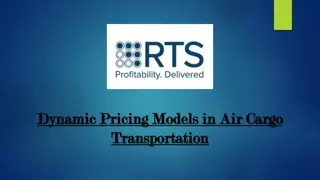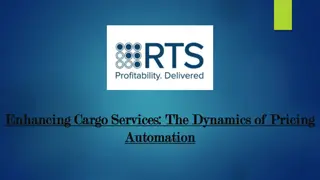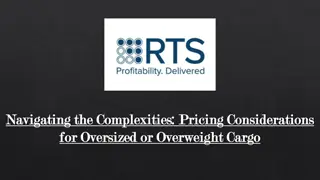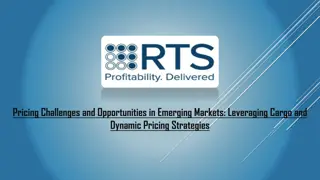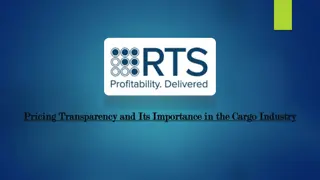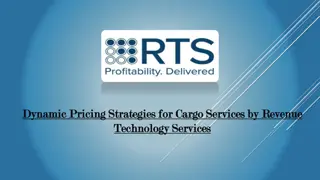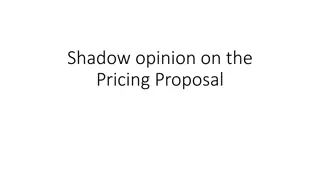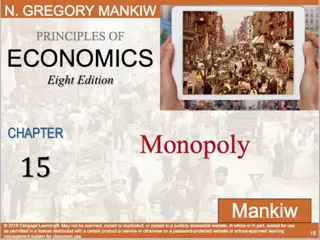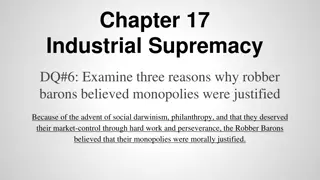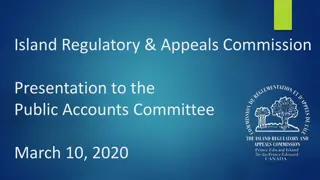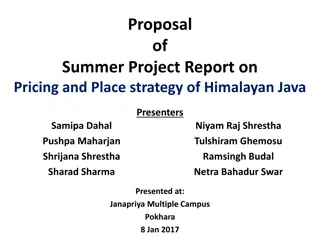Optimal Pricing Strategies for Multiproduct Monopolies
This chapter delves into optimal pricing strategies, focusing on subadditivity and multiproduct monopolies. It explores the concept of natural monopolies in a multiproduct setting and analyzes the design of pricing policies for firms supplying single or multiple services. Discussions cover linear pricing, two-part tariffs, and the implications of government subsidies on pricing strategies.
Uploaded on Oct 07, 2024 | 0 Views
Download Presentation

Please find below an Image/Link to download the presentation.
The content on the website is provided AS IS for your information and personal use only. It may not be sold, licensed, or shared on other websites without obtaining consent from the author. Download presentation by click this link. If you encounter any issues during the download, it is possible that the publisher has removed the file from their server.
E N D
Presentation Transcript
Chapter 12 Optimal Pricing
Most firms supply multiple products or services Vocabulary Subadditivity Economies of scope Unsustainable Natural monopoly prevails in the multiproduct setting when the industry cost function is subadditive, so that all relevant output combinations are produced at minimum cost by a single firm
Optimal Pricing Policies Analyze the optimal design of pricing policies, first in a setting where the regulated firm supplies only a single service and then in a setting where the firm supplies multiple services
Optimal Pricing of a Single Service One example of a firm that sells only one service could be an electricity distribution company
Linear Pricing Linear (or uniform) pricing: There are at least three reasons why government subsidies are problematic 1) If the firm s total cost exceeds the revenue it collects from its customers, it is possible that the cost exceeds the corresponding benefit to consumers which means welfare would be higher if the service were not supplied 2) If a firm s management knows that the firm s losses will be offset by a subsidy, the management may have limited incentive to control the firm s costs 3) It is often not apparent why citizens who do not purchase the service supplied by the natural monopoly should be required to subsidize consumption by other citizens
Nonlinear Pricing Two-part tariffs Nonlinear pricing can help to reduce the welfare losses that arise under linear pricing The parts of a two-part tariff are (1) a fixed fee, F and (2) a constant per-unit price, P One potential drawback to a two-part tariff is that some consumers may be unable to afford a large fixed fee Two-part tariffs generally can be designed to achieve a higher level of aggregate welfare than can linear pricing
Nonlinear Pricing Multipart tariffs Electricity, water, and telephone utilities often implement multipart tariffs Consider the pros and cons of the declining-block tariff example regarding a local telephone service
Optimal Pricing of Multiple Services Ramsey Pricing Regulated enterprises often supply multiple services Ramsey prices: the linear prices that minimize deadweight welfare losses while equating the monopolist s total revenue and total cost The mathematical Ramsey rule is Value of service pricing
Non-Ramsey Pricing of Telephone Services The Ramsey pricing rule is considered a sound principle, but regulators do not always follow the rule Consider how AT&T operated before 1984 Network externalities: benefits that accrue to all network subscribers as more subscribers join the network Prices other than Ramsey prices can be optimal when other goals (such a universal access) prevail or when particular emphasis is placed on the welfare of particular groups of consumers
Optimal Pricing in Two-Sided Markets Consider a supplier of broadband Internet access services (BIAS) that serves two sides of a market The standard Ramsey pricing rule typically is not optimal when a firm serves two sides of a market The welfare-maximizing rule for the linear prices set by a monopoly firm that serves two sides of a market is
Rate Structure A common cost is a cost that is incurred in supplying multiple services and would not be avoided if just one of the services were no longer supplied FDC pricing stands for fully distributed cost pricing
FDC Pricing Two drawbacks to FDC pricing procedures are 1) They typically fail to produce prices that maximize welfare 2) They can engender serious disputes among customer classes
Avoiding Inefficient Entry The stand-alone cost: when regulators can allocate common costs so as to produce a price for each service that exceeds the average cost of producing the service in isolation It is not always possible to find prices that preclude inefficient entry
Time of Use Pricing Costs of Power Production Time of use (TOU) pricing: when a firm might charge a different price for the same service at different times during the day Types of generating units electricity suppliers employ to meet the time-varying demand for electricity Baseload units Peaker units
TOU Pricing Model To explain the principles of TOU pricing most clearly, it is helpful to consider a simpler approximation of the setting
Summary In this chapter we Reviewed the key principles of optimal pricing in regulated industries Noted that although marginal cost prices maximize aggregate welfare, they can impose financial losses on the regulated supplier in the presence of a natural monopoly Characterized welfare-maximizing prices in two-sided markets and explored the value of time-of-use pricing in settings where marginal costs of production differ substantially at different times during the day



